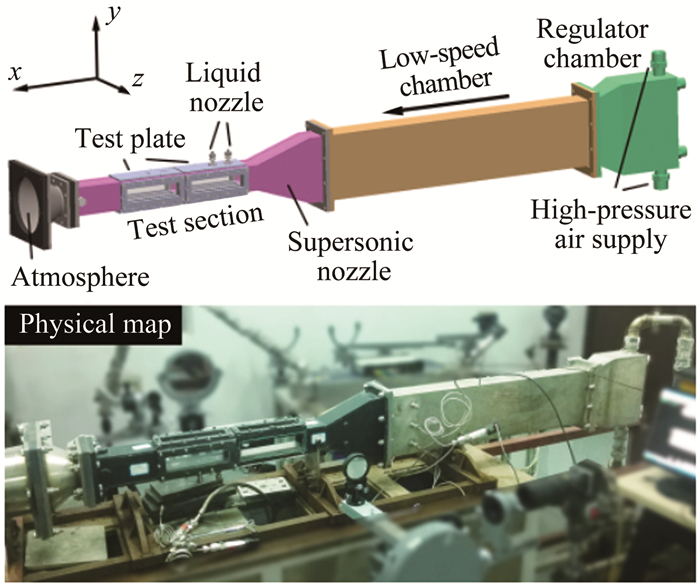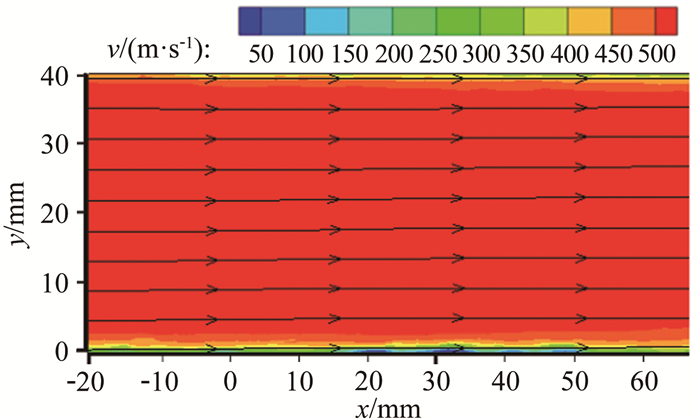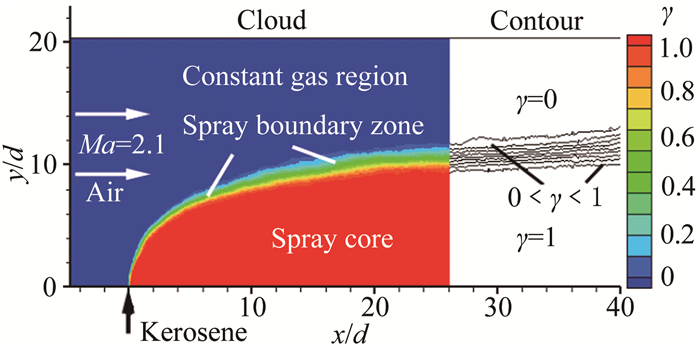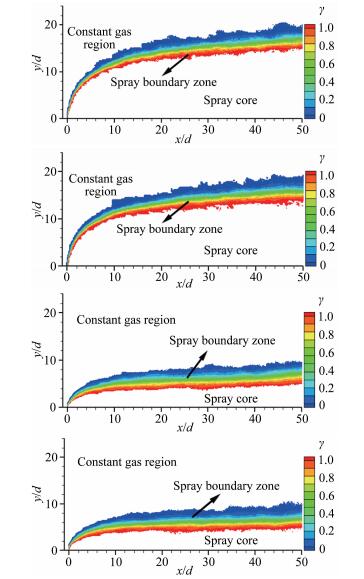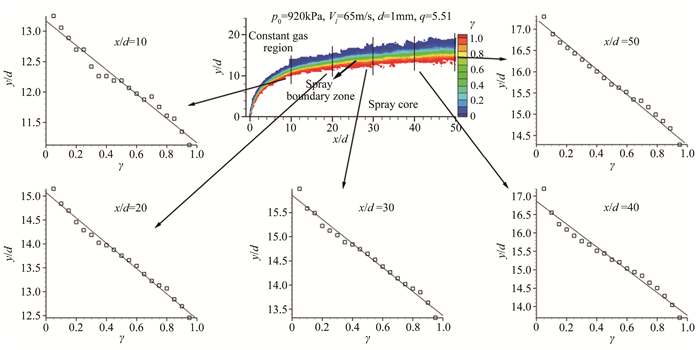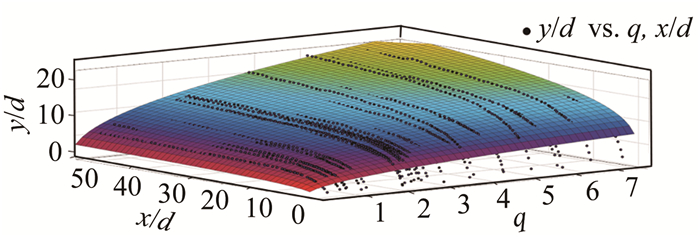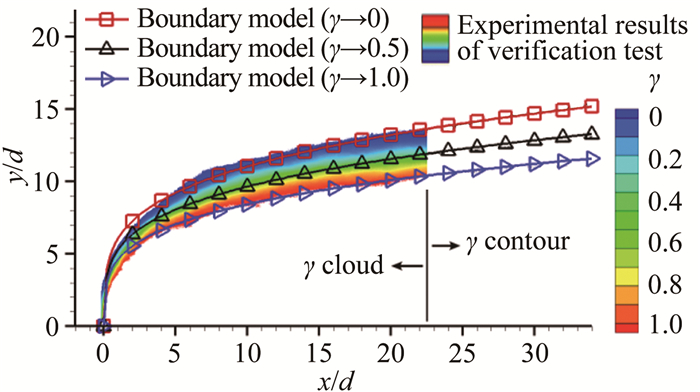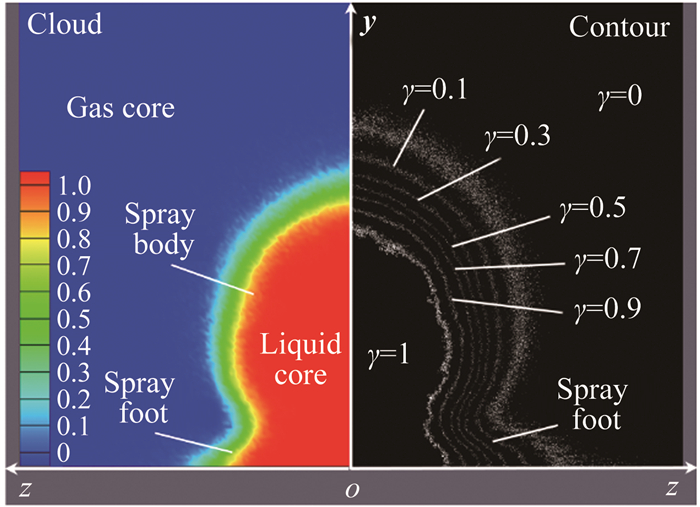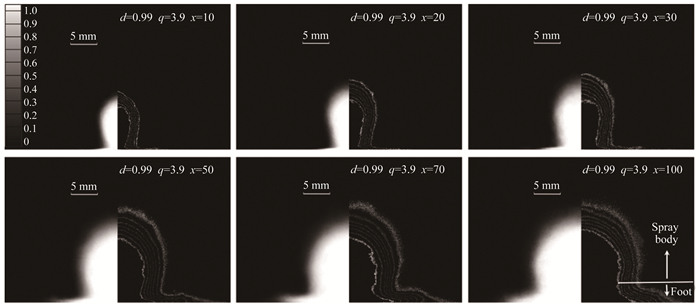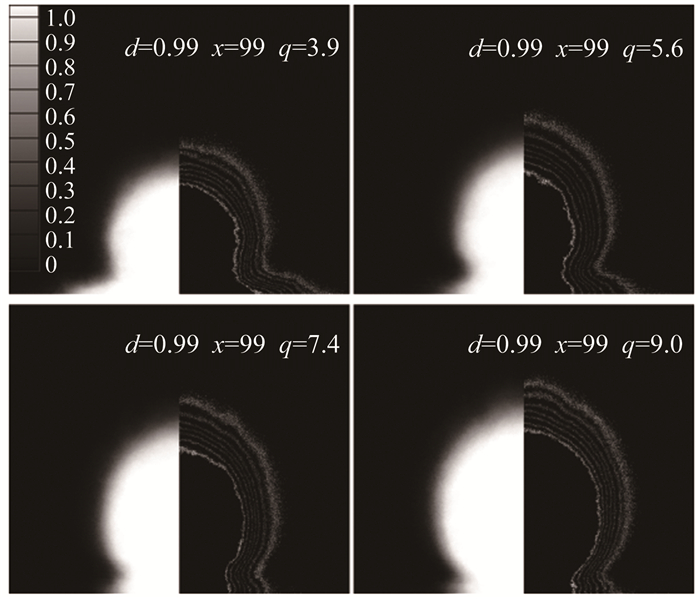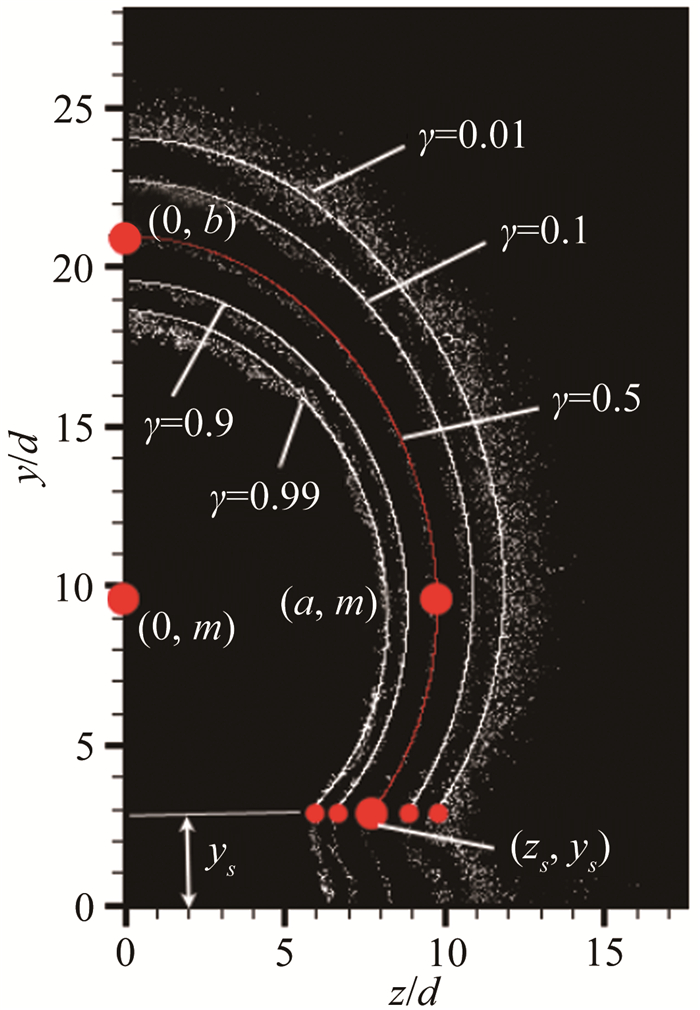Model for three-dimensional distribution of liquid fuel in supersonic crossflows
-
摘要: 针对超声速气流中液体横向射流的空间振荡分布特性开展试验研究,建立射流/喷雾在纵向和三维空间内的振荡分布预测模型。试验在Ma2.1下吹式风洞中进行,采用脉冲激光背景成像方法和基于PIV原理的倾斜成像方法分别捕捉纵向和不同横截面上的喷雾瞬态分布结构,涉及的研究参数及其变化范围包括:超声速来流总压(642~1010kPa)、液体喷孔直径(0.48~2.07mm)、距离喷孔的流向距离(10~125mm)以及液气动量比(0.11~10)。通过研究,提出并定义一种用于定量描述射流/喷雾空间振荡分布的无量纲参数——喷雾分数(γ),基于喷雾分数开展了纵向喷雾振荡分布研究,建立了纵向边界带模型,并开展了模型准确性验证。研究并发现了横截面上喷雾振荡分布呈"Ω"型,提出spray body和spray foot的分区概念,构造egg-shape曲线对spray body区域的喷雾分数等值线进行拟合,建立了egg-shape曲线方程中6个关键系数的系数模型,进而建立了超声速气流中液体横向射流空间振荡分布预测模型。Abstract: The spatial oscillation distribution characteristics of liquid jet in a supersonic crossflow were studied experimentally. Two models were built for predicting the oscillation distribution in the longitudinal and three-dimensional space, respectively. The experiments were carried out in a blow-type wind tunnel with Mach number of 2.1, and various conditions were studied, including stagnation pressure of the supersonic airflow (642~1010kPa), nozzle diameters (0.48~2.07mm), distance down from nozzle (10~125mm), practical pressure ranges (0.5~4.5MPa), and jet-gas momentum flux ratio ranges (0.11~10). Pulse laser background imaging method (PLBI) was used to shoot the transient spray distribution structures from the side and PIV method was used to capture the structures in cross-sections. A key parameter (Spray Proportion, γ) was defined to quantify the spatial oscillation distribution of the spray. A longitudinal spray oscillation distribution study was carried out, a spray boundary band model was established, and the model accuracy was verified. In addition, a piecewise function of the egg-shape curve and parabola was adopted to fit the contour line to establish the model for the spatial distribution of the spray in the cross-section. Based on various cross-section distributions with multi-parameters, a mathematical model is proposed to describe the liquid spray spatial distribution.
-
Keywords:
- scramjet /
- liquid jet /
- atomization /
- oscillation distribution
-
0 引言
随着人们消费水平的提升和消费观念的升级, 汽车NVH (Noise, Vibration, Harshness)性能中的车内噪声水平越来越受到消费者的关注。汽车在高速行驶时, 由外部气流引起的气动噪声是车内噪声的主要来源之一[1]。
在汽车的开发过程中, 由于风洞实验成本高, 数值模拟已成为研究车辆气动噪声的主要手段, 而准确的噪声分析是建立在精确的流场数据基础之上的。因此, 提高流场计算精度十分必要。
大涡模拟(LES)是计算非定常流场的常用方法。该方法利用滤波函数对流场中的涡进行尺度划分, 对大尺度的涡结构进行直接求解, 对小尺度的涡结构则采用亚格子模型进行建模, 而汽车气动噪声的产生与流场中小尺度涡旋的形成与运动有着重要的关系。滤波处理后的N-S方程将产生表征大、小尺度相互作用的亚格子应力项, 对亚格子应力项的求解通过构建亚格子模型进行。不同亚格子模型的选取会获得不同的流场结果, 进而导致不同的声场结果。
1 数值计算理论
1.1 流场数值计算方法
汽车运动的马赫数小于0.3, 其绕流可看作不可压缩流, 不可压N-S方程经过滤波后得到LES控制方程:

(1) 
(2) 式中, τij为亚格子应力项, 表示可求解的大尺度涡和不可求解的小尺度涡的动量交换:

(3) 为使方程封闭, 需构建亚格子应力模型, 即τij的表达式。采用Smagorinsky-Lilly、Dynamic Smagorinsky、WALE、WMLES、WMLES S-Omega以及Dynamic Kinetic Energy Subgrid-Scale Model 6种亚格子模型进行数值模拟。亚格子模型的τij表达式可写为:

(4) 式中,μt为湍流涡粘度,


(5) 在Smagorinsky-Lilly模型[2]中, 湍流涡粘度:

(6) 其中,

(7) 式中, k为冯卡尔曼常数; d为近壁面的距离; Cs为Smagorinsky常数, 通常取0.1;Δ为亚网格尺寸, 由网格尺寸V确定, Δ=V1/3; Ls为亚格子尺度的混合长度。
动态Smagorinsky(Dynamic Smagorinsky)亚格子尺度模型[3]中, Cs基于运动尺度求解得出。该模型添加了网格滤波和检验滤波函数, 进一步得出湍流应力张量:

(8) 式中, Tij为滤波后的亚格子应力项。
通过Lilly最小二乘分析, 最终得到Cs表达式为:

(9) 式中:

(10) 局部涡粘度壁面自适应模型[4](Wall-Adapting Local Eddy-Viscosity Model, WALE)中湍流涡粘度为:

(11) 式中, 亚格子尺度的混合长度Ls和应变率张量Sijd的表达式为:

(12) 
(13) 式中, 常数Cw=0.325,


(14) 代数形式的壁面函数模型[5](Algebraic Wall-Modeled LES Model, WMLES)在边界层内部使用雷诺平均方法进行模拟, 在边界层外部使用LES进行模拟。WMLES可应用于更高雷诺数的流场模拟, 其湍流涡粘度:

(15) 式中, dw为计算点与壁面的距离; S为应变率; 常数k=0.41, CSmag=0.2;Δ为亚网格尺度:

(16) 式中, hmax是六面体单元的最大边长, hwn是壁面法线方向网格间距, 常数Cw=0.15。
由于无法为恒定的剪切流提供零涡流粘度, WMLES模型在分离剪切层时会产生过大的涡粘性。在式(15)中, 若将S替换为|S-Ω|的差分形式, 则可以改进WMLES模型, 这种改进模型称为WMLES S-Omega模型, 其中Ω为旋涡强度。
动态动能亚格子模型[6](Dynamic Kinetic Energy Subgrid-Scale Model, KET)在传统Smagorinsky-Lilly模型上, 进一步考虑亚格子尺度湍动能的传输, 能更好地模拟亚格子尺度的湍流。亚格子湍流动能ksgs为:

(17) 湍流涡粘度μt通过亚格子湍流动能计算得出:

(18) 式中滤波尺寸Δf=V1/3, Ck根据流场状态获得。该模型的亚格子应力表达式为:

(19) 1.2 声学数值计算方法
采用莱特希尔声类比理论(Lighthill’s acoustic analogy)对气动声学进行求解。从流体力学的连续方程和动量方程推导得出莱特希尔方程:

(20) 其中:

(21) 式中, ρ'为流体密度波动量, c0为声音在均质介质中的速度, Tij为莱特希尔张量, ui为速度矢量沿i方向的分量, pi、ρ为流体的压力和密度, p0、ρ0分别为参考压力和密度,

应用格林函数进行积分可对莱特希尔声类比方程求解, 但对于复杂边界, 格林函数往往难以获得。Oberai等人提出一种新的求解方法[7], 通过获得频域下的莱特希尔方程变分形式, 采用有限元法进行求解。
如图 1所示, 气流流经的固体区域为ΩS, 固体区域的边界为ΓS。流体区域为Ωf, 流体是非均匀的或者湍流的, 受N-S方程控制。在Ωa和Ω∞区域, 流体状态是均匀的。另外, 湍流区域(声源区)的外边界为Γf, 声学截断面Γa为无反射边界。n为区域Ωt=Ωf∪Ωa向外的法向向量。对于任意速度矢量u, 可用un= u · n =uini来表示其法向分量。
基于莱特希尔方程, 利用转换等式:

(22) 得到莱特希尔方程的频域形式:

(23) 式中, ψ=-b/iω, b为总熵, i(非下标)为虚数单位。
基于Oberai提出的变分公式, 可得:

(24) 式中, δψ为测试函数。利用格林函数进行变分转换, 同时结合动量方程, 最终得到弱解形式:

(25) 采用有限元法进行内声场求解。在一个由边界面Ω所包围、声源分布为q的流体域V中, 任意空间点(x, y, z)的声压p受二阶赫姆霍兹方程控制:

(26) 式中, k=ω/c=2πf/c为波数, c为声速, ρ为流体密度, ω为圆频率。
将式(26)转换为等效的加权残差积分方程:

(27) 式中,


(28) 式中nV为区域V向外的法向向量。
在有限元方法中, 连续体V离散成一系列有限小单元以及节点ne, 在每个单元内, 利用形函数Nie, 声压p可用一定数量np的



(29) 式中, nf为整个离散域的节点总数, N为全局形函数的(1×nf)向量,


(30) 式中, B为全局形函数梯度分量的(3×nf)矩阵。将式(29)和(30)代入到式(28)中, 得到:

(31) 式中, K为声学刚度矩阵, M为声学质量矩阵, Q i为声学激励向量, C为声学阻尼矩阵。未知节点的声压值

1.3 外部气流引发车内噪声的机理
在密封良好情况下, 泄露噪声、风振噪声的影响可以忽略。此时车内气动噪声可归结为以下两种机理[8]:(1)空气中的旋涡收缩与变形及其相互作用, 以及气流与壁面相互作用会产生气动噪声源, 多种气动噪声源向四周传递噪声, 其中到达玻璃壁面的声压会引起壁面的振动从而向模型内部传递噪声; (2)当气流流经玻璃表面时, 引起了壁面振动, 从而向模型内部传递噪声。
虽然作用在玻璃表面上的湍流压力的压力级数要比声压的压力级数大, 但是在传递效率上, 湍流压力的传递损失却比声压的传递损失要大。所以, 在研究外部流场诱发汽车内部气动噪声时, 需要同时考虑上述2种作用机理。
2 计算模型与设置
2.1 计算模型
采用的计算模型为现代汽车公司建立的简易汽车模型Hyundai Simplified Model(HSM), 参考相关文献[9-10]建立HSM模型。如图 2所示, 模型长2 m, 宽1 m, 高1 m, 壁面从外到内分别为12 mm铝、40 mm吸声材料、4 mm隔膜以及20 mm吸声材料, 玻璃均为4 mm厚。材料属性如表 1和2所示。
表 1 材料属性Table 1 The material properties材料 密度/(kg·m-3) 杨氏模量/GPa 泊松比 铝 2700 69 0.33 隔膜 2000 0.04 0.45 车窗玻璃 2500 70 0.22 空气 1.2 - - 表 2 吸声材料属性Table 2 Properties of sound absorbing materials密度/(kg·m-3) 声速/(m·s-1) 孔隙率 孔曲率 827 343 0.879 3.31 实验中, 通过垫片、密封剂、螺栓等将车窗玻璃安装在铝制外壳上。为了验证车窗玻璃边界条件对噪声传播和数值模拟的影响, 文献[11]对车窗玻璃表面内外的频率响应函数(FRF)、玻璃传递函数和车内混响时间进行了测量, 结果表明, 玻璃内外的FRF结果几乎相同。可以认为, 玻璃安装到铝制外壳上是两种材料的简单附着, 仿真模型的简化对计算结果的影响可以忽略。
2.2 流场计算
参考现代汽车公司风洞实验段的外形[12]建立的流场计算域如图 3所示, 计算域长20 m, 宽14 m, 高10 m, 模型距离入口4 m。模型表面网格尺寸为5 mm, 计算域外表面网格尺寸为500 mm。利用密度盒对模型附近网格进行加密, 2个加密区的最大网格尺寸为20和100 mm, 其中, 第一个密度盒包含了湍流较为剧烈的声源区。在模型表面划分5层边界层网格, 第一层厚0.2 mm, 增长率为1.2。整个计算域网格数量约为1500万, 边界条件和参数设置见表 3。
表 3 边界条件设置Table 3 Boundary condition setting边界 类型 数值 Inlet Velocity inlet 110 km/h Outlet Pressure outlet 0 Pa Others Wall - 采用Fluent进行流场计算。利用稳态结果作为瞬态的初始值进行计算, 以减少瞬态计算达到收敛的时间。分别使用上述6种亚格子模型进行瞬态计算, 以获得流场的速度和压力结果。考虑到气动噪声集中在中低频段, 本次计算的最高频率初步定为1000 Hz。根据奈奎斯特采样定理, 确定采样时长为0.08 s, 计算时间步长为2×10-4 s。
2.3 声场计算
采用Actran进行声学计算, 使用积分插值的方法将流场信息映射至声学网格。外声场模型如图 4所示, 分为声源区、声传播区和无限元边界, 无限元边界为无反射边界。实验风洞为声学风洞, 壁面进行了吸声处理, 采用无反射边界和实验保持一致。根据分析, 频率的波长内至少包含6个网格单位的要求, 确定声场的网格尺寸为40 mm。采用四面体网格对外声场进行划分, 最终网格数约为140万。
图 5为内声场模型局部网格。玻璃和隔膜使用三棱柱网格划分, 其余部分使用四面体网格划分, 网格尺寸和外声场相同。
为了和实验数据[9, 11]对比, 在模型内部建立2个监测点, 监测点位置如图 6所示。
3 结果分析
3.1 流场结果
由流场决定的CFD截止频率fc为:

(32) 式中, ε为湍动能耗散率, Δx为网格尺度。
图 7为CFD截止频率分布图, 由图可知在湍流核心区域, CFD截止频率大部分在1000 Hz左右, 符合计算要求。
3.2 声场结果
图 8和9为1/3倍频程频率中心点的声压级。总体来看, 声压级Lp随频率f的上升而逐渐降低, 不同亚格子模型计算得到的结果的变化趋势和实验一致, 但在数值上有偏差。上述2个监测点的总声压级以及和实验值的误差如表 4和5所示。
表 4 监测点1总声压级及其误差Table 4 Overall sound pressure level and error of monitoring point 1SLM DSLM WALE WMLES WMLES S-Omega KET 实验值 总声压级/dB 90.1 90.8 80.4 77.2 80.2 85.9 71.6 误差/% 25.8 26.8 12.3 7.8 12.0 19.9 - 表 5 监测点2总声压级及其误差Table 5 Overall sound pressure level and error of monitoring point 2SLM DSLM WALE WMLES WMLES S-Omega KET 实验值 总声压级/dB 90.3 90.4 83.7 77.5 76.1 86.2 73.1 误差/% 23.5 23.7 14.5 6.0 4.1 17.9 - 3.3 结果分析
从总声压级看, 只有WMLES模型的结果误差在10%以内, 其余模型误差都较大。所以采用WMLES模型计算总声压级的精度更高。
由频谱曲线可知, 100~160 Hz, 6种亚格子模型得到的计算结果均大于实验值; 160~500 Hz, 计算结果均小于实验值; 500~1000 Hz, 计算结果和实验结果基本一致。在200 Hz时, 实验曲线出现峰值, 原因可能是该频率点为模型的固有频段, 共振使得声压级增大, WMLES和WMLES S-Omega模型准确地捕捉到了这一信息。
声场结果和流场结果有着直接的联系, 高频段结果和流场中小旋涡的变化及相互作用有关。出现低频段计算结果高于实验值、高频段计算结果低于实验值的原因可能是受计算资源的限制, 数值模拟没能精确捕捉到流场中的小旋涡运动, 导致部分高频段能量计入低频段。
在近壁面附近, 湍流尺度随壁面距离的减小而线性减小。所以, 壁面附近小尺度的旋涡占主要部分。由1.3节可知, 壁面附近的流场对车内噪声有着显著的影响。壁面附近气流模拟的精确性将直接影响车内噪声的计算结果。
LES在处理近壁面的流场时需要非常精细的网格尺度和非常小的时间步长(y+=1)。WMLES模型对LES进行了改进, 在处理近壁面流场时使用RANS进行模拟, 其余部分使用LES进行模拟。RANS在求解近壁面流场时, 不需要LES所要求的非常精细的网格尺度, 使其在求解高雷诺数下近壁面湍流更加有效。
在LES中, 亚格子模型表示了大、小旋涡的相互作用。几种亚格子模型的区别在于对湍流涡粘度μt的建模方式不同。湍流模拟中, μt对小尺度旋涡的形成与运动有很大的影响。在对μt建模过程中, 和网格尺寸有关的亚网格尺度Δ是一个重要的参数。其余亚格子模型采用网格体积的1/3次方定义Δ, WMLES模型改变了Δ的定义, 综合考虑了网格边长、网格中心点离壁面距离和网格法向尺寸, 此外建模时还考虑了y+值, 使得WMLES模型对壁面附近的旋涡捕捉更为精确, 而其余模型计算得到的湍流衰减过大, 这一点在文献[5]中已有体现。200 Hz时, WMLES及其改进模型WMLES S-Omega能够捕捉到峰值, 和其能够准确捕捉流场信息有关。
4 结论
基于不同亚格子模型, 对HSM模型进行了流场和声场的计算, 并与实验结果进行了对比分析, 结果表明:采用相同网格尺度时, 基于WMLES亚格子模型的LES数值模拟能较为准确地获得车外气动声源。
-
表 1 工况参数表(表中Ma为气流马赫数,T0为气流总温,p0为气流总压,d为喷嘴流道直径,l为喷嘴流道长度,Δp为液体喷注压降,Vl为射流出口平均速度,q为液气动量比)
Table 1 The list of key parameters (Ma is mach number, T0 is stagnation temperature, p0 is stagnation pressure, d is nozzle diameter, l is nozzle length, Δp is injection pressure, Vl is velocity of liquid jet, q is momentum flux ratio of liquid to gas)
No. Supersonic crossflow (Ma=2.1; T0=300K) Kerosene jet (density: 800kg/m3; l=1.5mm) p0/kPa d/mm Δp /MPa Vl /(m·s-1) q 1~8 920 1.52 0.48~3.93 23~69 0.68~6.16 9/10 714 1.52 0.43/1.24 22/38 0.84/2.46 11/12 792 1.52 0.48/1.35 23/40 0.82/2.41 13~18 923 1.25 0.58~4.10 22~61 0.62~4.85 19 1010 1.25 1.92 41 2.04 20 820 1.25 1.87 41 2.47 21 719 1.25 2.26 45 3.44 22 645 1.25 2.00 43 3.40 23~29 915 1.00 0.36~4.61 18~72 0.42~6.84 30~32 797 1.00 2.81~4.39 57~71 4.97~7.49 33~36 795 0.48 0.63~4.55 15~23 0.11~0.78 37 642 0.48 4.33 22 0.92 38 742 0.48 4.37 23 0.80 39 947 0.48 4.37 23 0.63 40 1.00 3.80 表 2 工况参数表(表中Ma为气流马赫数,T0为气流总温,p0为气流总压,d为射流喷孔直径,q为液气动量比)
Table 2 The list of key parameters (Ma is mach number, T0 is stagnation temperature, p0 is stagnation pressure, d is nozzle diameter, q is momentum flux ratio of liquid to gas)
No. d/mm x/d q Gas crossflow 41~44 0.68 100 1.6/3.4/6.1/10 Ma=2.1 45~46 0.99 10 3.7/5.5 T0=300K 47~48 0.99 20 3.9/5.7 p0=891kPa 49 0.99 30 3.9 50~51 0.99 50 3.9/5.6 52 0.99 70 3.9 Water Jet 53~56 0.99 100 3.9/5.6/7.4/9 ρ=1000kg/m3 57~60 1.25 100 1.1/2.4/3.7/4.9 Tw=300K 61~64 1.51 66 1.4/2.7/4.1/5.5 65 2.07 10 2.3 66 2.07 30 1.1 67 2.07 45 2.3 -
[1] 邓帆, 叶友达, 焦子涵, 等. HIFiRE项目中气动/推进一体化高超声速飞行器设计研究[J].实验流体力学, 2017, 31(2):73-80. http://www.syltlx.com/CN/abstract/abstract11014.shtml Deng F, Ye Y D, Jiao Z H, et al. Research on HIFiRE project's hypersonic vehicle integrated design of aerodynamic and scramjet propulsion[J]. Journal of Experiments in Fluid Mechanics, 2017, 31(2):73-80. http://www.syltlx.com/CN/abstract/abstract11014.shtml
[2] Boudreau A H. Status of the U.S. air force HyTech program[R]. AIAA-2003-6947, 2003.
[3] 冮强, 王辽, 郭金鑫, 等.基于总温测量的超燃冲压发动机燃烧效率研究[J].实验流体力学, 2012, 26(4):1-5. DOI: 10.3969/j.issn.1672-9897.2012.04.001 Gang Q, Wang L, Guo J X, et al. Scramjet combustion efficiency studies based on the total temperature measurement[J]. Journal of Experiments in Fluid Mechanics, 2012, 26(4):1-5. DOI: 10.3969/j.issn.1672-9897.2012.04.001
[4] Wang Z G, Wu L Y, Li Q L, et al. Experimental investigation on structures and velocity of liquid jets in a supersonic crossflow[J]. Applied Physics Letters, 2014, 105(13):134102. (WOS:000343031700091) DOI: 10.1063/1.4893008
[5] Wu L Y, Wang Z G, Li Q L, et al. Breakup and coalescence of kerosene droplet group in a Mach 1.86 supersonic crossflow[J]. Applied Physics Letters, 2014, 107(10):104103. (WOS:000361640200066)
[6] Wu L Y, Wang Z G, Li Q L, et al. Study on transient structure characteristics of round liquid jet in supersonic crossflow[J]. Journal of Visualization, 2016, 19(3):337-341. DOI: 10.1007/s12650-015-0328-4
[7] Forde J M, Molder S, Szpiro E J. Secondary liquid injection into a supersonic airstream[J]. Journal of Spacecraft and Rockets, 1965, 3(8):1172-1176.
[8] Yates C. Liquid injection into supersonic airstreams[R]. AIAA-1971-724, 1971.
[9] Baranovsky S I, Schetz J A. Effect of Injection angle on liquid injection in supersonic flow[J]. AIAA Journal, 1980, 18(6):625-629. DOI: 10.2514/3.50798
[10] Lin K C, Kennedy P J, Jackson T A. Spray penetration heights of angle-injected aerated-liquid jets in supersonic crossflows[R]. AIAA-2000-0194, 2000.
[11] Ghenai C, Sapmaz H, Lin C X. Penetration height correlations for non-aerated and aerated transverse liquid jets in supersonic cross flow[J]. Experiments in Fluids, 2009, 46(1):121-129. DOI: 10.1007/s00348-008-0547-8
[12] Lin K C, Kennedy P J, Jackson T A. Structures of water jets in a Mach 1.94 supersonic crossflow[R]. AIAA-2004-971, 2004.
[13] Perurena J B, Asma C O, Theunissen R, et al. Experimental investigation of liquid jet injection into Mach 6 hypersonic crossflow[J]. Experiments in Fluids, 2009, 46(3):403-417. DOI: 10.1007/s00348-008-0566-5
[14] 徐胜利, Archer R D, Milton B E, 等.煤油在超声速气流中非定常横向喷射的实验观察[J].空气动力学学报, 2000, 18(3):272-279. DOI: 10.3969/j.issn.0258-1825.2000.03.003 Xu S L, Archer R D, Milton B E, et al. Experimental investigation on unsteady transverse injection of kerosene into a supersonic flow[J]. Acta Aerodynamica Sinica, 2000, 18(3):272-279. DOI: 10.3969/j.issn.0258-1825.2000.03.003
[15] 王冬, 俞刚.煤油射流在超声速燃烧室中的实验研究[J].实验流体力学, 2005, 19(2):11-13. DOI: 10.3969/j.issn.1672-9897.2005.02.003 Wang D, Yu G. Investigation of kerosene jet spray in supersonic combustion[J]. Journal of Experiments in Fluid Mechanics, 2005, 19(2):11-13. DOI: 10.3969/j.issn.1672-9897.2005.02.003
[16] 费立森, 徐胜利, 王昌建, 等.高速冷态气流中煤油雾化现象的实验研究[J].中国科学(E辑:技术科学), 2008, 38(1):72-78. http://cdmd.cnki.com.cn/Article/CDMD-10358-2008091933.htm [17] 潘余, 王振国.激波对超声速流中横向射流的影响[J].国防科技大学学报, 2007, 29(6):6-9. DOI: 10.3969/j.issn.1001-2486.2007.06.002 Pan Y, Wang Z G. Shock impinge on supersonic cross flow injection[J]. Journal of National University of Defense Technology, 2007, 29(6):6-9. DOI: 10.3969/j.issn.1001-2486.2007.06.002
[18] 刘静, 王辽, 张佳, 等.超声速气流中横向射流雾化实验和数值模拟[J].航空动力学报, 2008, 23(4):724-729. http://d.old.wanfangdata.com.cn/Periodical/hkdlxb200804023 Liu J, Wang L, Zhang J, et al. Experimental and numerical simulation of atomization of liquid jet in supersonic crossflow[J]. Journal of Aerospace Power, 2008, 23(4):724-729. http://d.old.wanfangdata.com.cn/Periodical/hkdlxb200804023
[19] 陈亮, 乐嘉陵, 宋文艳, 等.超声速冷态流场液体射流雾化实验研究[J].实验流体力学, 2011, 25(2):29-34. DOI: 10.3969/j.issn.1672-9897.2011.02.006 Chen L, Le J L, Song W Y, et al. Experimental investigation of liquid jets atomization in supersonic cold crossflow[J]. Journal of Experiments in Fluid Mechanics, 2011, 25(2):29-34. DOI: 10.3969/j.issn.1672-9897.2011.02.006
[20] 曹娜, 徐青, 曹亮, 等.脉冲全息技术在发动机射流雾化场测量中的应用[J].现代应用物理, 2013, 4(4):323-329. DOI: 10.3969/j.issn.2095-6223.2013.04.004 Cao N, Xu Q, Cao L, et al. Measurement of spray characterization of engine nozzle by pulsed holography[J]. Modern Applied Physics, 2013, 4(4):323-329. DOI: 10.3969/j.issn.2095-6223.2013.04.004
[21] Yang H, Li F, Sun B. Trajectory analysis of fuel injection into supersonic cross flow based on schlieren method[J]. Chinese Journal of Aeronautics, 2012, 25(1):42-50. DOI: 10.1016/S1000-9361(11)60360-9
[22] 李锋, 吕付国, 罗卫东, 等.超声速气流中液体横向射流的破碎特性[J].北京航空航天大学学报, 2015, 41(12):2356-2362. http://d.old.wanfangdata.com.cn/Periodical/bjhkhtdxxb201512022 Li F, Lyu F G, Luo W D, et al. Breakup characteristics of li-quid jet in supersonic cross flow[J]. Journal of Beijing University of Aeronautics and Astronautics, 2015, 41(12):2356-2362. http://d.old.wanfangdata.com.cn/Periodical/bjhkhtdxxb201512022
[23] 刘林峰, 徐胜利, 郑日恒, 等.超声速气流中凹槽结构煤油喷射和掺混研究[J].推进技术, 2010, 31(6):721-729. http://d.old.wanfangdata.com.cn/Periodical/tjjs201006011 Liu L F, Xu S L, Zheng R H, et al. Studies on kerosene injection and mixing with cavity in supersonic flow[J]. Journal of Propulsion Technology, 2010, 31(6):721-729. http://d.old.wanfangdata.com.cn/Periodical/tjjs201006011
[24] Humble R A, Peltier Bowersox S J, R D W. Visualization of the structural response of a hypersonic turbulent boundary layer to convex curvature[J]. Physics of Fluids, 2012, 24(10):148-154. http://www.wanfangdata.com.cn/details/detail.do?_type=perio&id=e7ab9ac234a00e47fbac6b61d7dfd985
[25] 吴里银, 王振国, 李清廉, 等.超声速气流中液体横向射流的非定常特性与振荡边界模型[J].物理学报, 2016, 65(9):178-186. http://d.old.wanfangdata.com.cn/Periodical/wlxb201609023 Wu L Y, Wang Z G, Li Q L, et al. Unsteady oscillation distribution model of liquid jet in supersonic crossflows[J]. Acta Physica Sinica, 2016, 65(9):178-186. http://d.old.wanfangdata.com.cn/Periodical/wlxb201609023
-
期刊类型引用(3)
1. 许建林,公沛霖,张春博,贾永兴,李睿,杨永刚. 不同边界条件下单圆柱气动噪声大涡模拟研究. 空气动力学学报. 2024(12): 78-87 .  百度学术
百度学术
2. 吴鹏,张华. 高速矩形水舌表面破碎的大涡模拟. 水利技术监督. 2022(04): 106-112 .  百度学术
百度学术
3. 姚远,赵文彬,卢武,党朋,魏建华. 多风速段下低风阻导线抗风能力实验分析及导线截面结构参数优化. 电力系统保护与控制. 2021(21): 97-106 .  百度学术
百度学术
其他类型引用(14)







 下载:
下载:








